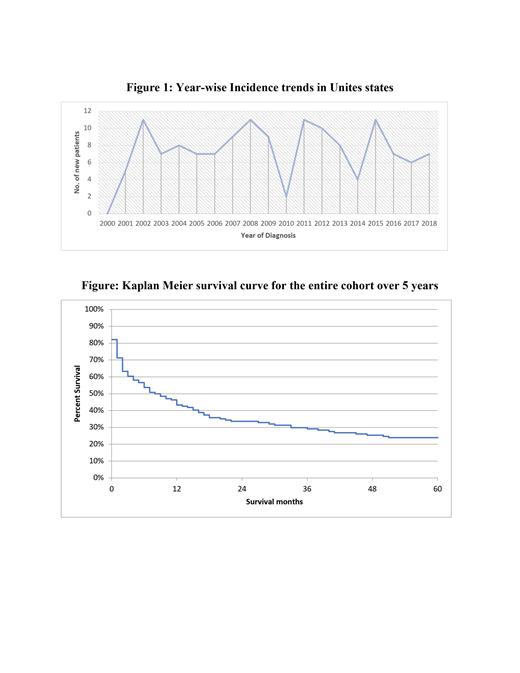Abstract
INTRODUCTION
Aggressive NK-cell leukemia ( ANKL) is a systemic lymphoproliferative disorder of natural killer (NK) cells frequently associated with Epstein-Barr virus (EBV) which has been grouped under histiocytic/dendritic neoplasms in the 2008 WHO classification of hematopoietic neoplasms. Due to rarity of diagnosis, the current available literature is limited to case reports and case series. This population-based study using Surveillance Epidemiology and End result program (SEER) is the largest to explore demographic characteristics, survival patterns and long-term outcomes in patients with ANKL in the United States.
MATERIALS AND METHODS
We utilized SEER 18 November 2020 submission database to select all patients (> 1 years of age) diagnosed from 2000-2018 with ANKL using International Classification of Diseases for Oncology edition 3 (ICD-O-3) code of 9948/3. Patients were divided into various cohorts based on age (<60 years, 60-79 years, >80 years), sex, race (Caucasians, African American, Asian/Pacific islander and American Indians/Alaska natives) and median household income of county of residence (< $ 50,000 vs > $50,000). We used SEER*stat to calculate age adjusted incidence rate using 2000 US standard population. Kaplan Meier curve was utilized to calculate 5-year overall survival. Cox proportional hazard model was used for multivariate analysis of factors associated with survival and p<0.05 was considered significant.
RESULTS
A total of 140 patients were identified with ANKL. The median age at diagnosis is 58 years. The crude, age-adjusted to 2000 US standard population and age-specific incidence rate of HCD in Unites states is < 1/100, 000 respectively. The incidence in males is 1.9 times that of females- 92 males (65.7%) and 48 females (34.2%). Between 2001-2018, minimum number of cases were diagnosed in 2010 (n=2).Out of the cohort, 107 patients were White (76.4%), 21 patients were Asian or Pacific islander (15 %), 9 patients were African Americans (6.4%) and 3 patients were American Indian/Alaska native (2.1%). The median overall survival was 7 months (95% CI; 0-16). Survival rates at 1year, 2 years and 5 years were found to be 45.3% , 37.1 % and 31.1% respectively [Figure 1]. 5 year overall survival rates are as follows- Whites ( 69.7% ), Blacks ( 63.1%), American Indian (59.9%), Asian or Pacific Islander ( 66.8%). On multivariate analysis, black race was associated with poor outcomes (p 0.008), whereas sex, income and age had no significant effect on cancer outcomes.
CONCLUSIONS
Our study shows that ANKL is a rare hematological malignancy in general population with a poor median survival of less than one year. Males are twice more likely to be affected than females with poor outcomes in africo-americans.
No relevant conflicts of interest to declare.


This feature is available to Subscribers Only
Sign In or Create an Account Close Modal